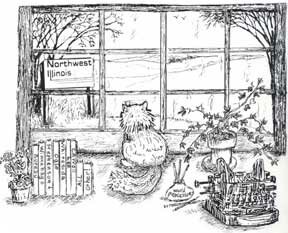
Discover rewarding casino experiences. 
|
The 1914 Lee County history stated that in its introduction to Brooklyn Township one identified more popularly as “Melugin’s.” John Dixon encouraged Zachariah Melugin to settle twenty miles to the southeast of the ferry on the Rock River to provide a stage stop at the comfortable distance between inns. Their meeting and friendship had begun during the Black Hawk War and Melugin had only returned to his former home near Springfield to take care of his business and then laid claim to land in section four where, with a cabin built, he welcomed the first Chicago-Galena via Dixon stage coach on January 1, 1834. And the rest, as they said, is history with regular transportation going through the Northwest to bring “civilization.” That east side of Lee County would remain mostly rural/agricultural for nearly forty years. A quote states that it was an area of “remarkable beauty” and it still is. The soil is rich and black, once part of the vast Winnebago Swamp, now drained. Grain bins and elevators numerously dot the countryside, many now being private enterprise not merely businesses they had been the first structures in the long ago... Many have been the dramatic events that punctuated the years, you’d think though not touching the serenity of the rolling prairie. But, of course, they did ... Life, death, new technology, modern methods. Local and global events touched the residents of Melugin’s Grove as every place, their impetus creating new ideas and way of life including, naturally, the railroad that knifed through the township beginning in 1873 when reference gave that the “Kinyon Railroad” built about a mile to the south of Melugin’s settled nearly forty years before.
What was the Kinyon Railroad? We find no other reference to the name ... An investor, a foreman, the CEO? Later source states that the Chicago, Burlington and Quincy was the railroad that went through Compton, the village begun ON the tracks to the south of Melugin’s ... “All the glamour and tradition went out of the old grove as the stage coach and route disappeared.” Joel Compton platted out a town on the tracks in 1873, Compton, promoting it with a grid of streets and business district and, of course, the ubiquitous grain elevator. One by one buildings from the Melugin Grove territory were moved to Compton; a church or school, a house, a commercial building and so forth, so through there was a somewhat familiar look to the new village it would take some getting used to setting beside the tracks. Within another forty years a neat little village had become home to about three hundred fifty and there was a bank, furniture, hardware, harness maker, wagon maker, blacksmith, groceries and general merchandise, the usual necessary goods and trades. And the history of 1914 stated “With the old buildings moved and new ones gone up, love for the old place (the grove) was strong and ties were hard to break—descendants of the old Melugin stock are so closely interwoven that nearly every family is related to nearly every other family. The sturdy old times established fortunes that the young ones today are enjoying.”(!) At that time land was selling for $200 an acre, apparently top price. The soil was so fertile and productive that crops were nearly assured. Sidetracks to park the freight cars taking away crop and livestock were constantly busy, while along the streets substantial houses rose one-by-one similar to the one pictured here ... They can be seen yet today side-by-side, unique for their size and the example of the chapter of history they marked. A worthwhile sight yet today ... And another quote “Every resident of the place has an automobile” indicating that keeping up with the Comptonites used the recently invented automobile as its measuring stick. At that time every house had its own cement sidewalk, too, another standard. The C.B.Q. ran through Compton and wouldn’t you know, the Chicago Milwaukee St. Paul Railroad laid tracks a mile east, not through, north and south so as to avoid making Compton an intersecting crossroads! The company built a grain elevator itself, calling it “Roxbury Station” that took some business away from private enterprise. The thing that gave Compton prestige, however, was its hospital the Chandler Hospital named for its medico, Dr. A.W. Chandler. The person writing the Compton chapter at the time rather gushed over the fact, saying things such as “it sprang into national fame—most noted surgeon in the country—most important enterprise in town—patients from the Atlantic and Pacific have come for treatment—big institution in Lee County—and for the amelioration of suffering, it outranks any institution in the land.” Although at that period of time many small towns had hospitals such as nearby Sublette with its “House of the Twilight Sleep” (a birthing practice) and at Milledgeville Dr. Sword’s home was part hospital with his wife, as well as Dr. Changkler’s being the anesthesiologist when needed. (Both those hospitals have been featured in PDQ Me.) Admiringly, the writer said its reputation extended far and wide and no spot in northern Illinois was so well-known. However, it doesn’t say what its specialty was! The doctor retired in this solid, commodious residence and likely enjoyed his neighborhood where houses so like his in their expansive design were hallmark of their time. See to appreciate them as symbols of their era. Indeed, times did change around Melugin’s Grove. One day there’d been Indians camping throughout, Chief Shabbona, a long-time friend to the incoming white man. There were well-known visitors that became historical figures such as Joseph Smith who stayed at local inns, apparently passing up and down the state. And, it’s said, beginning a Mormon Temple at what became the west edge of Amboy at Rocky Ford on Green River. A Mormon cemetery was organized, too, but now, unfortunately, plowed under. A nearby doorstep is said to have been part of the foundation for the temple. Oh, how that construction would have changed the direction of our history here in the Northwest. Then at the early time, mostly in the 1840’s, the banditti of the prairie held prominence and attempted to recruit some of the Melugin Grove residents to join their hell-for-leather-riding gang ... Counterfeiting, murdering lonely travelers for their pocketbooks, stealing horses and spiriting them to distances by way of their organized “franchises” in different parts of the Midwest. At another grove, Washington Grove in Ogle County, a possé of vigilantes, a hundred or so, killed the “Driscoll Gang” which made headlines and was topic for dime novels. Then came the railroads, crops, farms, villages. The settlers have been excellent stewards of the fertile prairie and the groves, but they, too, had their differences. History mentions that there grew up a “fierce rivalry” between Comptonites and their contemporary village over west, West Brooklyn, it being platted at the same time. You’d have identified the sections between them as a kind of No Man’s Land had there not been a third plan for a third town smack dab in the middle between them, Carnahan. Don’t you kind of wish there’d be more written about the “fierce rivalry?” But no! The Compton section merely ends with this: “Many retired farmers live there while others have gone to Dixon; others decline to break old home ties and all of them are rich.” Next Week —The Competition.
|





